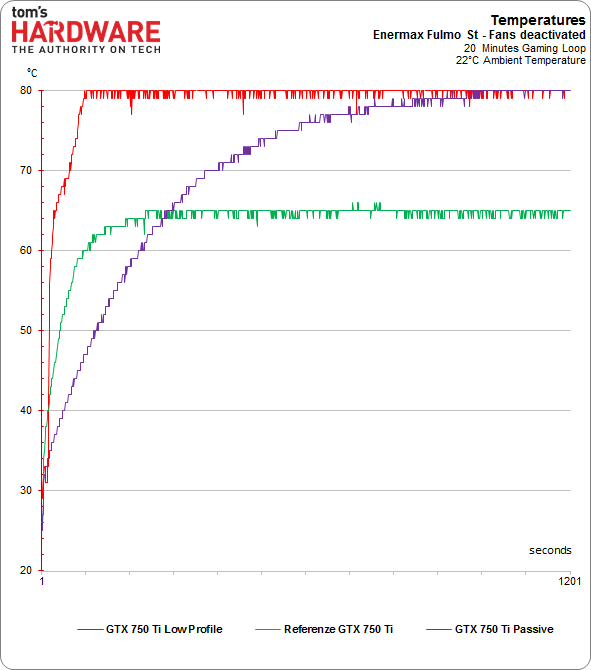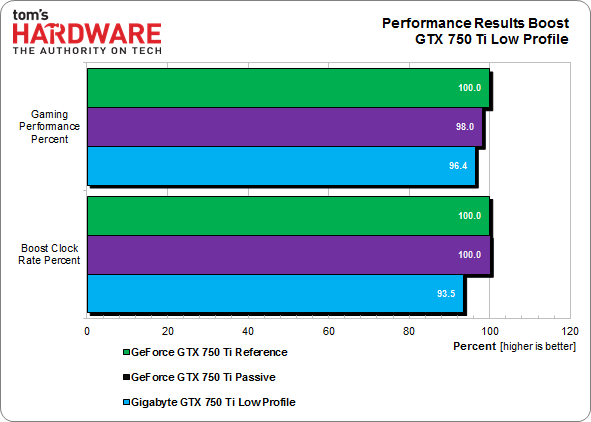Build Your Own: Single-Slot GeForce GTX 750 Ti
We already proved that it's possible to game on a GeForce GTX 750 Ti with a passive heat sink. Now we're going to do the same thing with a single-slot cooler. Can you build your own low-profile board based on GM107? Sure, if you have the right AMD donor.
Performance, Temperature, And Noise
Our thermal readings come from a long loop of Metro Last Light, which is meant to stress the card with a demanding load and represent other 3D scenarios. This is a particularly taxing title, and it's possible that temperatures would even be lower in less intensive games.
| Model | Idle | Gaming Load |
|---|---|---|
| GeForce GTX 750 Ti Reference | 28 °C | 65 °C |
| GeForce GTX 750 Ti Passive | 29 °C | 80 °C |
| GeForce GTX 750 Ti Low Profile | 29 °C | 80 °C |
As with our passively-cooled GeForce GTX 750 Ti, this single-slot version with its small heat sink and fan is helped by Nvidia's 80 °C temperature target. Whenever the GPU hits 80 degrees, it gets throttled to make sure it doesn't exceed that value.
And here's where theory hits the real world, and the impact of throttling makes itself apparent. The chart with the GPU Boost clock rates will give us a better understanding of how frequencies correspond with frame rates later on.
Real-World Gaming Performance
So what do those numbers mean in reality? Even though Nvidia's GPU Boost clock rate falls by about 6.5%, measured frame rates only drop by 3.6%. In an average gamer's day, that's a negligible difference. A title that was previously playing back at 30 FPS falls close to 29; that's going to be hard to notice with your eyes.
As a result of Nvidia's thermal protection mechanism, though, you can really use whatever cooling solution you want. Just look at the reference GeForce GTX 780, 780 Ti, and Titan cards. They're able to run almost silently thanks to a capable design and GPU Boost's fast response.
Noise
First, we'll check noise under a couple of different workloads. Measurements are taken using a studio-quality microphone with the same calibration we use for our PC audio testing. The mic is positioned vertically in the center of the graphics card, 50 cm away.
| Model | Idle | Gaming Load (Open Test System) |
|---|---|---|
| GeForce GTX 750 Ti Reference | 31.5 dB(A) | 34.1 dB(A) |
| GeForce GTX 750 Ti Passive | N/A | N/A |
| GeForce GTX 750 Ti Low Profile | 32.1 dB(A) | 38.5 dB(A) |
At idle and under load, the single-slot cooler is louder than Nvidia's little reference-class orb-style cooler. However, the acoustic output is what we'd consider to be acceptable. The combination of a small heat sink and proactive thermal protection technology is certainly favorable to burning the card or running at higher clocks with obnoxious fan speeds.
Get Tom's Hardware's best news and in-depth reviews, straight to your inbox.
Current page: Performance, Temperature, And Noise
Prev Page Meet The Finished Product Next Page Wrap-Up: Single-Slot GeForce GTX 750 Ti
Igor Wallossek wrote a wide variety of hardware articles for Tom's Hardware, with a strong focus on technical analysis and in-depth reviews. His contributions have spanned a broad spectrum of PC components, including GPUs, CPUs, workstations, and PC builds. His insightful articles provide readers with detailed knowledge to make informed decisions in the ever-evolving tech landscape
-
de5_Roy i've been waiting to read it for a while. it was very good.Reply
one aspect of gcn based radeons is that despite their low power use in entry level cards, all of them use higher amount of pwoer during bluray playback. both kepler and maxwell (gm107) use quite less. a single slot, low profile operation, a card with gpu like gm107 will be very suitable for htpc. not to mention the sheer amount of gaming performance advantage over other gfx card around the same power use. hopefully, the future 20nm gpus will introduce even more performance under the same power use. -
dish_moose I get a little cautious about making holes in multi layer pcbs and using metal screws. Without knowing the power plane structure and clearances, you gamble shorting out internal layers if you are not lucky/careful.-BruceReply -
jamesedgeuk2000 I think I have noticed a flaw with what you guys did here. The card only supply's power to the fan it doesn't regulate PWM or sense RPM, so am I correct in assuming that it's using voltage regulation to control fan speed and therefore doing it blind based on it's temperature curve? If so then as you have replaced the standard fan with a much weaker one you should really consider raising the fan curve to compensate.Reply -
CodeMatias Why not use a K2000 cooler? also nvidia small die so it might work better, and K2000 is ~80W so it should cool the 750ti just fine.Reply -
CodeMatias ReplyAnd now... fitting a Titan/780 Ti cooler to a 290X. ;)
Asus already did... It doesn't work, the 290X just draws too much power -
AndrewJacksonZA Reply
Yes silverblue, yes! :-)12865804 said:And now... fitting a Titan/780 Ti cooler to a 290X. ;)


